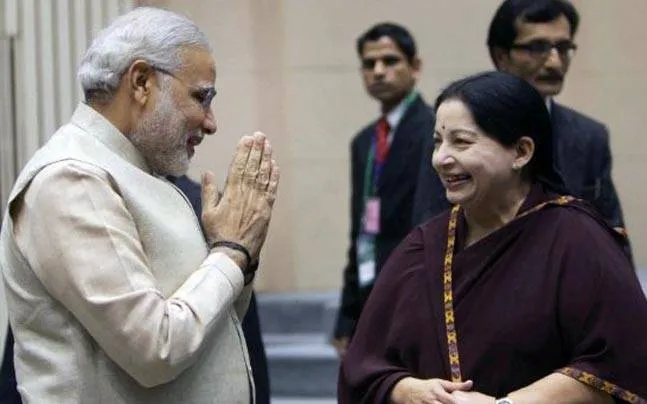Among the many irritating facets of Indian politics is that when a prominent politician dies, the eulogies that pour in tend to be trite and predictable, adding little to an already carefully-constructed public persona. Or they are so far removed from the leader's actual influence on our public life as to render the politician in question unrecognisable. They never help tell you exactly why someone should, in fact, be remembered.
The reaction to the announcement that the five-time Chief Minister of Tamil Nadu had passed away fits squarely within that framework. Film star, politician, "Amma", and so on: they do politics a disservice, by not viewing Jayalalithaa's legacy
in toto - which, as with anyone's, is both bad and good. And they do her a disservice, by treating her merely as a leader of Tamil Nadu, missing the real influence that she has had.
And that influence is great. For Jayalalithaa has become, for better or worse, the template that all India's successful Chief Ministers seek to follow. Of course, had she been a man, this fact would perhaps have been highlighted and celebrated; but, as a woman, the fact that she was a trailblazer in this respect seems to have been missed. (And, of course, there's the additional fact that aspects of this template are deeply problematic.)
Let's work out exactly how Jayalalithaa was the most influential state leader of the past three decades. (Remember, she became Chief Minister in 1991, well before most of the current crop of leaders; others who became Chief Minister in that period - Mulayam Singh Yadav, for example, or Lalu Prasad - have gone on to become the emeritus leaders of their parties. The other powerful Chief Ministers who fit the template we will build up all came to power well after Jayalalithaa did.)
In essence, there were four aspects to her approach to Chief Minister-ship.
First, she was an authoritarian. Her party, her government and her bureaucracy were completely subordinate to her will. It is said of her mentor, M G Ramachandran, that he would come up with an idea and leave the implementation to others, but Jayalalithaa managed everything carefully, precisely and personally. I have heard vivid stories of how she personally looked over even the management of the world chess championship match between Anand and Carlsen, cordoning off a section of the Hyatt Regency and managing logistics from there for part of the day.
The flip-side of this management style is that personal loyalty becomes paramount. The other "efficient Chief Ministers" who are widely praised - whether Nitish Kumar or, yes, Narendra Modi - simply follow in her footsteps. They too adopted this authoritarian model, with all its flaws and benefits. It means you can implement good ideas effectively, given the constraints of the Indian state machinery. But you can also make massive mistakes - demonetisation or prohibition - and lose your way trying to bend the state and people to your will. And it also means that if you, for some reason, lose effectiveness or are removed from the scene, the government can come to a halt - as happened in Tamil Nadu during Jayalalithaa's long illness.
One note on this authoritarianism: The slightly discomfiting pictures of AIADMK partymen prostate before her as she sits impassively are, yes, partly a consequence of this style. I don't want to minimise their significance - it means something to actually see a woman in such undeniable command, so comfortable wielding power over men in a patriarchal society. But I admit I was also a little uncomfortable because it was a Brahmin leader of a nominally Dravidian rationalist party who expected such prostration. I couldn't help remembering that it was a feature of the rule of Kamalapati Tripathi over the UP Congress in the 1970s and 80s - where there was no question that prostration was simply his due as the state's foremost Brahmin. It somehow didn't sit well with the supposed nature of her party. If her AIADMK meekly loses its identity to the BJP, as some suggest, that would be the strongest demonstration of how authoritarianism weakens parties in the long-run, and hollows them out from within.
The second aspect of the template she created was that she practically re-invented the idea of regionalism in recent Indian politics. When she took office, a regional leader was always a crusader, but an ethnic one. You would take pot-shots at the Hindi belt or at outsiders or at the notion of a unitary India. NTR in Andhra Pradesh was a "Telugu
bidda" first, and the Congress, his enemy, was imposing Delhi's alien rule on India. But from her first speeches in the Rajya Sabha in the 1980s through her Chief Ministership, Jayalalithaa took sub-regionalism into the 21st century. Her arguments with the Centre were heated; she always sought to check Delhi's power. But they were always closely argued, and subject to constitutional propriety. More importantly, perhaps, they were political but not framed in narrow ethnic terms. She took the first step in the journey that sub-regionalism has traversed from NTR and Prafulla Mahanta to Nitish Kumar demanding cash, Mamata a say in foreign affairs and Chief Minister Modi arguing with the Centre over the GST. From that point of view, India is a stronger and more united state today because of Jayalalithaa - an unexpected legacy, perhaps, for a leader of a Dravidian party.
Third, she was "business-friendly". The notion that we have today of a Chief Minister - someone whom is, essentially, their state's chief sales officer, the first point of contact for a big investor; an initiator of and trouble-shooter of private-public partnerships; and the direct court of final appeal for a distressed investor was developed in part by Jayalalithaa's two early tenures. It's worth noting that she went all-in to the notion of PPPs (Private Public Partnerships), in infrastructure in particular, even when many in other states, after the Enron-Dabhol fiasco, were dubious. Don't get me wrong: this is a pernicious and unsustainable model - "business-friendly" isn't the same as "market-friendly". It's created considerable damage to the Indian economy that will take long years to repair. But, again, it's a crucial part of being a "good" Chief Minister today - even Mamata Banerjee has to conform to that notion - and Jayalalithaa helped invent it, well before Modi or his peers.
Fourth, she helped re-invent welfarism. She cannot take credit for this alone; she must share it with both her mentor, MGR, and her great rival, Karunanidhi - as well as others, such as NTR, who pioneered the notion of cheap rice. But the notion of "freebies" - which are, in fact, ways to provide welfare to voters that avoid the problems with existing welfare schemes - is certainly something she helped make politically sustainable. Everyone credits Nitish for his political brilliance in giving schoolgirls bicycles - but Jayalalithaa did it in 2004. (No doubt being a woman helped in framing woman-friendly welfare schemes.) Every Chief Minister now is supposed to compete politically on the nature and the efficiency of their welfare schemes; this was invented in Tamil Nadu. Note that it is substantially different from, say, what happens in Kerala and other social spending-heavy states, where welfare is driven by ideology; here, it is an integral part of political competition. We can argue over whether that is good or bad, but well before it became the national norm, Jayalalithaa embodied it.
These four characteristics of the "strong Chief Minister" today - authoritarianism, constitutional subregionalism, a "business-friendly" approach, and political welfarism - were first combined into a coherent whole by Jayalalithaa. For good or bad, she was one of our greatest political innovators, and blazed the trail that dozens of state leaders since have followed. That's how, I think, she should be remembered.
This commentary was first published in NDTV.com
The views expressed above belong to the author(s). ORF research and analyses now available on Telegram! Click here to access our curated content — blogs, longforms and interviews.




 PREV
PREV


